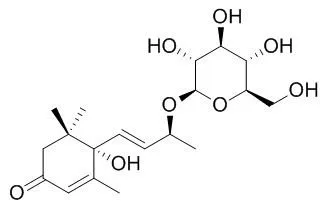| Structure Identification: |
| Molecules. 2010 Apr 12;15(4):2593-9. | | A new sulfated alpha-ionone glycoside from Sonchus erzincanicus Matthews.[Pubmed: 20428066] | Sonchus erzincanicus (Asteraceae) is an endemic species in Turkey, where six Sonchus species grow.
METHODS AND RESULTS:
In this study, a phytochemical study was performed on the aerial parts of the plant. The study describes the isolation and structure elucidation of five flavonoids and two a-ionone glycosides from S. erzincanicus. The compounds were isolated using several and repeated chromatographic techniques from ethyl acetate and aqueous phases that were partitioned from a methanol extract obtained from the plant. 5,7,3',4'-Tetrahydroxy-3-methoxyflavone (1) and quercetin 3-O-beta-D-glucoside (2) were isolated from the ethyl acetate phase, while Corchoionoside C 6'-O-sulfate (3), Corchoionoside C (4), luteolin 7-O-glucuronide (5) and luteolin 7-O-beta-D-glucoside (6), apigenin 7-O-glucuronide (7) were isolated from the aqueous phase. Corchoionoside C 6'-O-sulfate (3), isolated for the first time from a natural source, was a new compound.
CONCLUSIONS:
The structures of the compounds were elucidated by means of 1H-NMR, 13C-NMR, 2D-NMR (COSY, HMQC, HMBC) and ESI-MS. | | Chem Pharm Bull (Tokyo). 1997 Mar;45(3):464-9. | | Medicinal foodstuffs. V. Moroheiya. (1): Absolute stereostructures of corchoionosides A, B, and C, histamine release inhibitors from the leaves of Vietnamese Corchorus olitorius L. (Tiliaceae).[Pubmed: 9085554] |
METHODS AND RESULTS:
Three new ionone glucosides named corchoionoside A, corchoionoside B, and Corchoionoside C were isolated from the leaves of Corchorus olitorius, commonly called "moroheiya" in Japanese, together with seven known compounds, an ionone glucoside (6S,9R)-roseoside, a monoterpene glucoside betulalbuside A, two flavonol glucosides astragalin and isoquercitrin, two coumarin glucosides scopolin and cichoriine, and chlorogenic acid. The absolute stereostructures of corchoionoside A, corchoionoside B, and Corchoionoside C were determined by chemical and physiochemical evidence, which included the result of application of a modified Mosher's method, the CD helicity rule, and chemical correlation with (6S,9R)-roseoside.
CONCLUSIONS:
Corchoionosides A and B and (6S,9R)-roseoside were found to inhibit the histamine release from rat peritoneal exudate cells induced by antigen-antibody reaction. |
|






 Cell. 2018 Jan 11;172(1-2):249-261.e12. doi: 10.1016/j.cell.2017.12.019.IF=36.216(2019)
Cell. 2018 Jan 11;172(1-2):249-261.e12. doi: 10.1016/j.cell.2017.12.019.IF=36.216(2019) Cell Metab. 2020 Mar 3;31(3):534-548.e5. doi: 10.1016/j.cmet.2020.01.002.IF=22.415(2019)
Cell Metab. 2020 Mar 3;31(3):534-548.e5. doi: 10.1016/j.cmet.2020.01.002.IF=22.415(2019) Mol Cell. 2017 Nov 16;68(4):673-685.e6. doi: 10.1016/j.molcel.2017.10.022.IF=14.548(2019)
Mol Cell. 2017 Nov 16;68(4):673-685.e6. doi: 10.1016/j.molcel.2017.10.022.IF=14.548(2019)